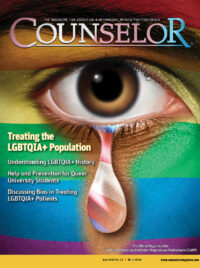Share
In celebrating LGBTQIA+ Pride Month every June, we honor the endeavors of many who came before us. It has become a time of much-needed celebration, perhaps now more than ever, in the wake of the COVID-19 pandemic. We are also experiencing a pushback in some states for rights and freedoms previously won, which once again requires queer individuals to speak up and take action.
June is also a month to celebrate graduations, and for high school students it was a major accomplishment completing their education online or in hybrid classrooms, even missing a number of social events due to physical restrictions. For those who are continuing their education, there will be a new level of anxiety. It is well documented that being away from home can be very stressful for many students, while some high school graduates are excited about going away to school. On the other hand, there are some students who deliberately look for a “party school” and focus on the newly acquired personal freedom being away from home provides. Most colleges and universities recognize this and include discussions on substance use, eating disorders, and sexual violence prevention as part of their freshman orientations.
As the Substance Abuse and Mental Health Services Administration (SAMHSA) reported in 2019,
Alcohol, illicit drug, and tobacco use is more common among young adults than in any other age group. Substance misuse among college students reflects this broader prevalence but has specific differences based on factors that include the college setting, culture, experience, and demographics. The most prominent feature of college substance misuse is excessive drinking, with the highest rates occurring among a growing population of eighteen- to twenty-two-year-olds who are full-time students. In addition to a long history of alcohol and marijuana use, increased misuse of medications has added a new dimension to college substance misuse.
During the pandemic, the percentages started to change. According to the National Institute on Drug Abuse (NIDA),
The percentage of adolescents reporting substance use decreased significantly in 2021, according to the latest results from the Monitoring the Future survey of substance use behaviors and related attitudes among eighth, tenth, and twelfth graders in the United States.
. . . “We have never seen such dramatic decreases in drug use among teens in just a one-year period. These data are unprecedented and highlight one unexpected potential consequence of the COVID-19 pandemic, which caused seismic shifts in the day-to-day lives of adolescents,” said Nora Volkow, MD, NIDA director. “Moving forward, it will be crucial to identify the pivotal elements of this past year that contributed to decreased drug use—whether related to drug availability, family involvement, differences in peer pressure, or other factors—and harness them to inform future prevention efforts”.
(2021)
A concern for LGBTQIA+ and gender nonconforming students is what campus life will be like for them. Unfortunately, what is missing is data on LGBTQIA+ college students in relation to support for substance use recovery. These students may wonder, “Will I find friends, peers, support, and an affirming environment for learning and socializing?” We know statistically that misuse of substances is higher in queer communities (NIDA, n.d.; Medley et al., 2016). This is especially true with tobacco use, along with alcohol and other drugs. Some students begin using “study-enhancing drugs” as a way to keep up with academic demands. While the pandemic may have limited the availability of some substances, students will still find ways to acquire them, including the misuse of prescribed medications. The availability and use of alcohol will likely always be present.
NIDA notes that individuals who identify themselves as lesbian, gay, bisexual, transgender, queer, intersex, or asexual/aromantic/agender (LGBTQIA+) “often face social stigma, discrimination, and other challenges not encountered by people who identify as heterosexual. They also face a greater risk of harassment and violence. As a result of these and other stressors, sexual minorities are at increased risk for various behavioral health issues” (n.d.).
College Recovery
NALGAP, the Association of Lesbian, Gay, Bisexual, Transgender Addiction Professionals and Their Allies, was formed in 1979 by a group of individuals attending the Rutgers Summer School of Alcohol Studies. Four years later in 1983, Lisa Laithman began working at Rutgers University as the first alcohol and drug counselor in the school’s history. She is responsible for creating The Rutgers Recovery House, the first residence hall on a college campus for students in recovery in the country when it opened in 1988 (Rutgers University, n.d.). According to the Recovery House website, “The community’s high recovery rate, averaging 95 percent, and a high average GPA of 3.2, demonstrates the success of this nationally recognized collegiate recovery model” (Rutgers University, n.d.). Many more colleges and universities are creating sober living programs for student addicts in recovery, following what Rutgers University started over thirty years ago.
Rutgers University also offers Rainbow Perspectives. Rainbow Perspectives is a gender-inclusive housing option for students interested in participating in a residential community that explores the diversity of LGBTQIA+ experiences through programs, dialogues, and community projects.
Moving Forward
Recovery housing and LGBTQIA+ residential community living are wonderful options for students. While I am very proud of the accomplishments we have made at Rutgers University, the setback is that students can choose one housing option or the other. If you are a young person in recovery who is queer or gender nonconforming, what choice would you make? Would you select the housing that supports your recovery, or the housing that affirms your sexuality or gender identity?
Regrettably, queer folks in recovery deal with this dilemma on a regular basis. Finding safe spaces to both affirm sexual minorities and support recovery is challenging. The following are various ways universities can demonstrate affirmation for LGBTQIA+ individuals:
- Health education or marketing materials should show images representative of LGBTQIA+ individuals, same-sex couples, and families.
- LGBTQIA+-specific signs, stickers, and brochures should be displayed in common areas.
- Community bulletin boards should include postings for LGBTQIA+ people.
- Student centers and student wellness waiting areas should have reading materials (e.g., newsletters, magazines) appealing to LGBTQIA+ people.
- Restrooms should be accessible to all genders.
We need also to do better to increase our capacity to meet the health needs of sexual minorities. There is work to be done here. There are steps to take that will encourage LGBTQIA+ individuals using substances or with behavioral health concerns to seek help—and for providers to provide it.
SAMHSA recommends sensitivity training for health care professionals in order to better understand how to meet the specific needs of the LGBTQIA+ community. They also offer nine principles of care for health care professionals to keep in mind (SOURCE):
- Be understanding and flexible
- Provide a comprehensive approach
- Be consistent with cultural needs
- Promote self-respect
- Promote healthy behaviors
- Support collective decision making
- Reduce barriers to treatment
- Provide evidence-based treatment
- Create a recovery community
We need to remember that recovery is about community, including LGBTQIA+ communities, and the various ways we can come together.
Intake and enrollment forms should specifically indicate sexual orientation and gender identities reflective of each individual. This includes asking students which name and pronouns they use as well as assuring that all faculty, staff, students, and clients respect every individual’s gender identity. There should also be corrective action when clients are misgendered. Acknowledging, recognizing, and affirming LGBTQIA+ individuals make a campus more visible as an ally and a safe space to all members of the LGBTQIA+ community.
As an individual working in higher education, I have personally and professionally benefited by being a member of the Consortium of Higher Education LGBT Resource Professionals. Our organizational vision speaks to the important work we do as well as the ways we assist other institutions that are just beginning to recognize the importance of LGBTQIA+ student services: “We envision higher education environments where LGBTQ people, inclusive of all of our intersecting identities, are fully liberated.” Our mission is that we are “a member-based organization working towards the liberation of LGBTQ people in higher education. We support individuals who work on campuses to educate and support people of diverse sexual orientations and gender identities as well as advocate for more inclusive policies and practices through an intersectional and racial justice framework” (Consortium of Higher Education LGBT Resource Professionals, 2020).
To close, I would like to share the words expressed by President Biden during this year’s Pride Month:
This month, we remind the LGBTQI+ community that they are loved and cherished. My Administration sees you for who you are—deserving of dignity, respect, and support. As I said in my State of the Union Address—especially to our younger transgender Americans—I will always have your back as your President so that you can be yourself and reach your God-given potential. Today and every day, my Administration stands with every LGBTQI+ American in the ongoing struggle against intolerance, discrimination, and injustice. We condemn the dangerous State laws and bills that target LGBTQI+ youth. And we remain steadfast in our commitment to helping LGBTQI+ people in America and around the world live free from violence.
(“A Proclamation,” 2022)
References
- “A proclamation on lesbian, gay, bisexual, transgender, queer, and intersex pride month, 2022.” (2022). Retrieved from https://www.whitehouse.gov/briefing-room/presidential-actions/2022/05/31/a-proclamation-on-lesbian-gay-bisexual-transgender-queer-and-intersex-pride-month-2022/
- Consortium of Higher Education LGBT Resource Professionals. (2020). Vision and mission statement. Retrieved from https://www.lgbtcampus.org/mission-statement
- Medley, G., Lipari, R. N., Bose, J., Cribb, D. S., Kroutil, L. A., & McHenry, G. (2016). Sexual orientation and estimates of adult substance use and mental health: Results from the 2015 National Survey on Drug Use and Health. Retrieved from https://www.samhsa.gov/data/sites/default/files/NSDUH-SexualOrientation-2015/NSDUH-SexualOrientation-2015/NSDUH-SexualOrientation-2015.htm
- National Institute on Drug Abuse (NIDA). (2021). Percentage of adolescents reporting drug use decreased significantly in 2021 as the COVID-19 pandemic endured. Retrieved from https://nida.nih.gov/news-events/news-releases/2021/12/percentage-of-adolescents-reporting-drug-use-decreased-significantly-in-2021-as-the-covid-19-pandemic-endured
- National Institute on Drug Abuse (NIDA). (n.d.). Substance use and SUDs in LGBTQ* populations. Retrieved from https://nida.nih.gov/research-topics/substance-use-suds-in-lgbtq-populations
- Rutgers University. (n.d.). Recovery housing. Retrieved from http://health.rutgers.edu/medical-counseling-services/counseling/adap/recovery-housing/
- Substance Abuse and Mental Health Services Administration (SAMHSA). (2019). Behavioral health among college students information and resource kit. Retrieved from In celebrating LGBTQIA+ Pride Month every June, we honor the endeavors of many who came before us.
About Me
Phil McCabe, CSW, CAS, CDVC, DRCC, is a health educator for Rutgers School of Public Health. Additionally, he serves as an adjunct instructor for Rutgers School of Nursing, School of Social Work, and Robert Wood Johnson Medical School. He has over thirty years of experience providing educational training. McCabe currently serves as the president of the National Association of Lesbian, Gay, Bisexual, Transgender Addiction Professionals and Their Allies (NALGAP).












 Counselor Magazine is the official publication of the California Association of Addiction Programs and Professionals (CCAPP). Counselor offers online continuing education, article archives, subscription deals, and article submission guidelines. It has been serving the addiction field for more than thirty years.
Counselor Magazine is the official publication of the California Association of Addiction Programs and Professionals (CCAPP). Counselor offers online continuing education, article archives, subscription deals, and article submission guidelines. It has been serving the addiction field for more than thirty years.